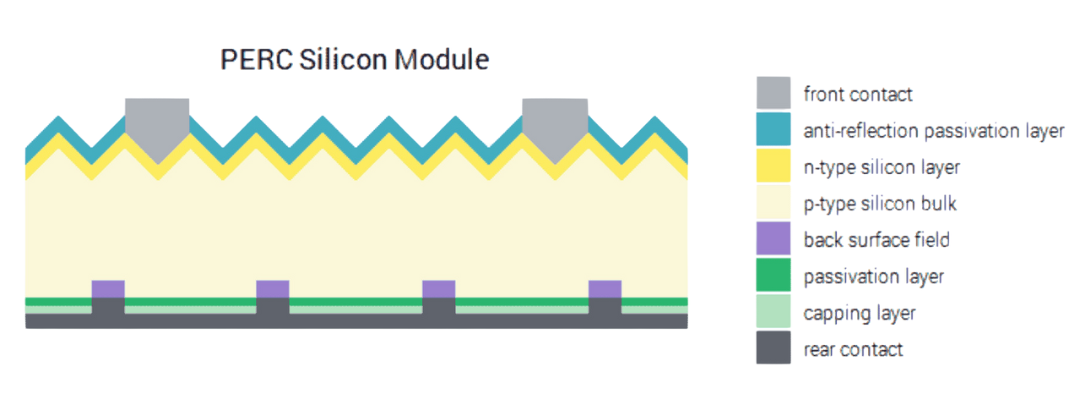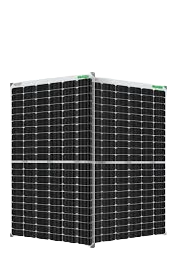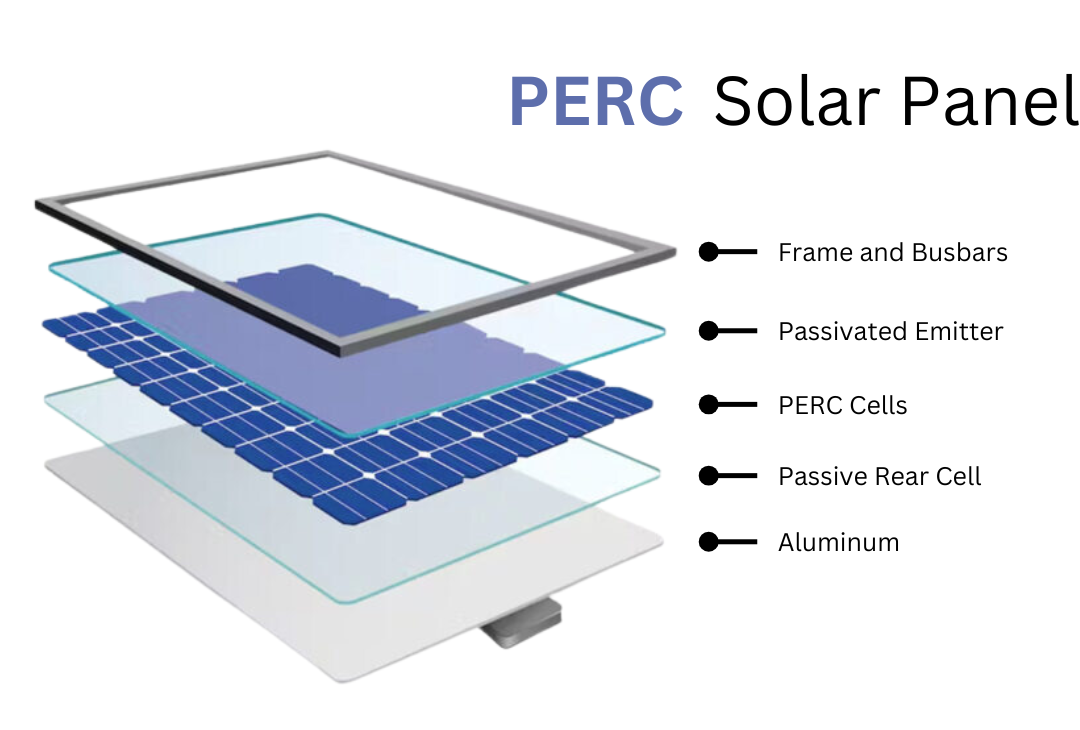As solar technology advances, new innovations emerge, boosting efficiency and affordability in renewable energy solutions. One such advancement is PERC solar panels. This technology has taken solar panel efficiency to a new level, making it a popular choice for residential, commercial, and industrial applications. In this comprehensive guide, we’ll explore everything you need to know about PERC solar panel, including how they work, their benefits, types, and key considerations for installation.
Table of Contents
What are PERC Solar Panels?
More efficiently than traditional solar panels, PERC solar panels use Passivated Emitter and Rear Contact (PERC) solar cells to transform sunlight into electricity. Traditional solar cells are improved using PERC (Passivated Emitter and Rear Cell) technology, which increases their capacity to absorb and transform sunlight. The additional layer on the cell’s rear, which reflects sunlight that would otherwise be lost, is the primary distinction between PERC solar panels and traditional panels.
How Do PERC Solar Panels Work?
PERC panels work by optimizing the rear side of each solar cell:
- Additional Passivation Layer: PERC cells feature a passivation layer on the back, which enhances light capture. This layer reduces recombination losses, where electrons and holes cancel out each other before generating electricity.
- Reflective Surface: The passivation layer acts as a mirror, bouncing sunlight back into the cell. This design ensures that sunlight that might have escaped is redirected into the cell for energy conversion.

Key Benefits of PERC Solar Panels
The innovation behind PERC solar panel offers several advantages:
1. Higher Efficiency
PERC panels are about 1% more efficient than traditional panels, and can be up to 3% more efficient in low light and high heat. This can increase energy production for a PV system by up to 5%.
2. Increased Low-light and High-heat Performance
PERC solar panels excel particularly well in both high-heat environments and low-light environments, with about a 3% increase in efficiency.
3. Enhanced Temperature Tolerance
PERC panels are more resilient in high-temperature conditions, ensuring optimal energy production even during warmer months.
4. Space Efficiency
With their higher efficiency, fewer PERC solar panels are needed to achieve the same energy output, which can save on space and installation costs.
5. Smaller Roof Footprint
Because PERC panels are more efficient, solar designers and installers need fewer of them to create the same power as traditional panels. This means a solar panel system using PERC panels can fit onto smaller roofs.
6. Greater Power Density
Due to their higher efficiency, PERC panels generate more power per square foot, allowing users to produce the same amount of electricity with fewer panels. This can reduce the footprint required for installation, making them ideal for areas with limited space, such as rooftops or urban installations.
7. Proven technology
PERC technology is a modification of standard cells, so there’s reduced risk for financiers.
Types of PERC Solar Panels
There are two primary types of PERC solar panel:
1. Mono PERC Solar Panels
Monocrystalline cells with an additional reflecting layer, known as mono PERC solar cells, increase efficiency by reabsorbing light that isn’t initially caught. By applying a dielectric passivation film to the rear surface of the cell, this technology—known as a Passivated Emitter and Rear Cell, or PERC—allows the cell to absorb both direct and dispersed light. Due to the increased efficiency and space-saving high energy density of monochromatic PERC panels, there is a great deal of research and development being done to improve this technology on a global scale.

2. Poly PERC Solar Panels
In India, polycrystalline solar cells are widely used since they are reasonably priced and qualify for government subsidies. India’s plentiful sunshine reduces the impact on energy generation, even though their efficiency is marginally lower than that of Mono PERC panels. Only polycrystalline cells now satisfy the Domestic Content Requirement (DCR), which requires the use of Indian-made cells for installations looking to get government subsidies because they are produced domestically rather than imported.

3. Bifacial PERC Solar Panels
These panels capture sunlight from both the front and the back, increasing total energy production. They use a double-glass structure or a transparent back sheet. High-efficiency panels can generate up to 25% more energy compared to single-sided panels, especially in high-reflectivity environments like sand or snow.

4. Dual Glass PERC Solar Panels
Dual glass or double-glass panels use two layers of glass to encase the solar cells instead of the traditional glass-and-backsheet design. Dual glass panels with PERC technology have similar efficiency to other PERC panels but offer greater durability and a longer lifespan.

PERC vs. Traditional Solar Panels
When comparing PERC panels to conventional solar panels, several distinctions stand out:
| Feature | PERC Solar Panels | Traditional Solar Panels |
|---|---|---|
| Efficiency | Higher | Moderate |
| Low-Light Performance | Excellent | Standard |
| Temperature Coefficient | Lower (better) | Higher (less efficient) |
| Cost | Slightly more expensive | Lower initial cost |
| Applications | Residential, commercial | Residential, large-scale |
Applications of PERC Solar Panels
Due to their versatility and efficiency, PERC solar panel are suitable for various applications:
1. Residential Installations
It can be used on homes for maximum energy production and savings on electricity bills.
2. Commercial Buildings
It can be used in office buildings, shopping centers, and warehouses to reduce electricity bills and carbon footprint.
3. Solar roof chargers for EVs
It can be used for EV solar roof chargers.
4. Large-scale solar farms
It are used in utility-scale solar power plants to generate electricity.
5. Building Integrated Photovoltaics (BIPV)
It can be used for Building Integrated Photovoltaics (BIPV).
Installation Considerations for PERC Solar Panels
While PERC solar panel offer numerous advantages, there are a few factors to consider for optimal installation:
- Shading and Positioning: Avoid shading as it can impact overall system efficiency. Proper positioning to capture maximum sunlight is crucial.
- Temperature: Although PERC panels are better suited for high temperatures, extreme heat may still impact performance. Appropriate mounting structures to allow airflow can help regulate panel temperature.
- Maintenance: Regular cleaning and maintenance can help ensure the panels operate at peak performance, especially in areas with high dust or debris.
Environmental Impact of PERC Solar Panels
The increased efficiency of PERC solar panel means more power with fewer materials, leading to a smaller environmental footprint. Furthermore, their durability and extended lifespan mean fewer replacements, reducing waste.
- Greenhouse gas emissions: It can reduce greenhouse gas emissions by up to 15% compared to traditional solar panels.
- Carbon footprint: It can have a lower carbon footprint than other power sources, such as natural gas.
- Energy consumption: It can reduce energy consumption.
- Resource depletion: It can reduce resource depletion.
- Lifespan: It can have a longer lifespan than traditional solar panels.
Potential Limitations of PERC Solar Panels
While highly efficient, PERC solar panel come with certain limitations:
- Higher Initial Cost: PERC panels are slightly more expensive than conventional panels due to the additional passivation layer.
- Potential Light-Induced Degradation (LID): PERC cells may experience LID, where exposure to sunlight slightly decreases their efficiency over time. However, high-quality PERC panels are designed to minimize this effect.
The Future of PERC Technology in Solar Power
The future for PERC solar panel looks promising. As technology advances, researchers are exploring ways to further enhance the efficiency and longevity of PERC cells, including bifacial PERC panels, which can capture sunlight from both sides. The growth of PERC technology is expected to play a pivotal role in the global shift towards renewable energy.
Conclusion: Are PERC Solar Panels Right for You?
The future of PERC technology in solar power is incredibly promising, with advancements poised to reshape energy efficiency and accessibility. As solar energy becomes a cornerstone in global sustainability efforts, PERC (Passivated Emitter and Rear Cell) technology is leading the way in maximizing output and reducing costs. Innovations within PERC continue to drive solar panel efficiency higher, making solar a viable option for a broader range of applications, from residential rooftops to large-scale commercial installations.
This technology’s ability to perform well in low-light conditions and withstand various climates makes it especially valuable in diverse geographical areas. Looking ahead, ongoing research aims to integrate PERC with emerging technologies, like bifacial and tandem cells, to further increase power output and durability. With these advancements, PERC technology is set to play a pivotal role in making solar energy more accessible, cost-effective, and adaptable to the growing global demand for clean energy.
Upgrade to PERC Solar Panels for Superior Efficiency – Contact Us to Learn More!
